Loanwords: Our ‘False Friends’ (Part 1)
Top photo: analogicus on Pixabay
MUSUBI presents the first in a two-part essay on one of the most useful but at times confusing parts of learning Japanese- the loanwords.
Part 1: I’ll meet you at the Coin Laundry for some Ice
Japanese people are known for their adaptability and creativity. By going
around big cities such as Tokyo, Yokohama, Osaka, and many more, one can see how the Japanese have skillfully mastered the art of fusing east and west. It
is evident in their art, food, architecture, fashion and language.
I was living in Australia when I met the most beautiful woman I’d ever seen. Three years later I’d moved to Japan to start a new life as a married man. Looking back, I think it was a risky but courageous move. Something I would probably think twice about if I have to make the same decision now. We communicated in English which meant that my Japanese vocabulary was “zero to none”.
Occasionally she would throw in words like オムライス (omu-rice or omelet rice), カレーライス (curry-rice or curry and rice), テレビ (televi, or television), フライドポテト (friend potato, or French fries) and a few others once in while. Most of the time I would get the gist, but there were times when I’d get a bit cranky because the words just don’t seem to fit the meaning, the usage, and the syntax.
Later on, when I started working and meeting people, I got more exposure to
the language. Knowing that I was a foreigner, they would frequently use English-like words, either to make me feel comfortable or impress me. Oftentimes it did the opposite. It would take me moments to analyze the context before I could figure out what they meant.
You know, that feeling when you talk about something very ordinary and the other takes a long time to react like it was some complex mathematical theory. Sometimes I got it right, but sometimes I didn’t get it all. It must have been frustrating for them, too.
Here are some of words that may sound familiar when you say them out loud, but actually carry a very different meaning.
1. Aparto (アパート) from the word ‘apartment’. Makes sense, right?
2. Mansion (マンション) refers to a condominium or an apartment building taller and bigger than an Aparto.
3. Pierce (ピアス) is how you say ‘earrings’.
4. Reform (リフォーム) means a newly renovated house, apartment or building.
5. Talent (タレント is a ‘TV personality’.
6. Coin Laundry (コインランドリー)means ‘laundromat’.
7. Paper Driver (ペーパードライバー)means a person who has a driver’s license but does not drive.
8. Part (パート) means a part time job or a part time worker.
9. Salary Man (サラリーマン)is a male office worker or company employee.
10. Office Lady (OL)is the female counterpart of a ‘salary man’
11. Soft Cream (ソフトクリーム) means soft serve ice cream
12. Ice (アイス)on the other hand means any kind of ice cream or frozen treat
As I adapted to life in Japan, I studied and learned how to use the language.
My Japanese is far from proficient, but it’s enough to get me where I want to go or tell you how I feel. I realized that there is a whole plethora of these ‘false friends’, pseudo-English or loanwords in the lingo (the proper term being 外来語, gairaigo). Learning the language takes a lot of time and discipline, but these words added up to my limited vocabulary. They are already familiar and easier to remember.
Personally, I still have reservations using them. I avoid doing so as much as I can, but when they’re being thrown at me, I’m able to understand easily and reply appropriately. Having these words at my disposal made small talks and casual communication easier, which helped me built friendships and relationships.
And then I became an English teacher, and things got complicated. But that’s a story for another time. Stay tuned for Part 2 next week!
Photo Credits:
Top photo: analogicus on Pixabay
All other content (text) created by the original author and © 2021 MUSUBI by Borderlink
Over the past 10 years, a traditional wooden toy has been making a resurgence throughout Japan. You may have seen it in stores or on TV. You may even have seen children (or adults) playing with one!
The toy is called “Kendama” (けん玉, “sword [and] ball”) and to the uninitiated, it’s just two cups, a spike and a ball attached to a string. However to a practitioner of kendama, it’s much more. It’s a lifestyle, a tool for connecting with others, a game, a way to pass the time, and even a good form of exercise of both mind and body.
The origins of kendama are debated, but it is said to have originated during the 17th or 18th century. A variant of the French cup-and-ball game Bilboquet, it was brought to Japan via the Silk Road and quickly developed into the homegrown variant we know today. Kendama has been evolving since the Edo period and today, you can find it being played not only in Japan, but all over the world.
It’s even played professionally and, unlike the traditional game, has a carefully-crafted set of rules to follow. There are many different play styles and designs, and the ‘kendama community’ connects through SNS, united by a love of the game.
Now, you’re probably thinking, “So what? That still doesn’t explain why I should get one.” And you’re absolutely correct. But once you start playing, even just a little, you can see the benefits that a kendama can have in your life. To name a few:
1. Playing kendama can improve dexterity and hand-eye coordination. There are many different tricks with varying degrees of difficulty that you can try to land.
2. You can play kendama alone or in a group with friends. A simple game of ‘ken can have you and your friends challenging each other to reach new heights.
3. Increase your heart rate and get some exercise anywhere, with kendama. Some tricks require you to bend your knees and move your body. Others require you to have balance and precise form.
4. You can play kendama almost anywhere! No batteries or 4G necessary!
There are many types of kendama and styles of play to choose from and as you improve your skills you can find one that suits you. But, if you’re looking for something to kill the time or connect with Japanese culture in a different way, definitely get a kendama.
Just be careful of the downspike; it can be dangerous!
Photo Credits:
All other content (text) created by the original author and © 2021 MUSUBI by Borderlink
Top photo: Jezael Melgoza on Unsplash
Living in Japan can be difficult, but also quite enjoyable, for a non-Japanese individual. Beyond just the language barrier, there are many cultural differences that can sometimes make it difficult for Japanese people and those from Western societies to relate to each other. But then, the same could be said of other countries, and even those of two different Western societies themselves in some cases.
However, it is my belief that if one is able to overcome those barriers, they will come out the other side a completely changed person capable of handling anything that life throws at them. There are also several experiences unique to Japan that make life here congenial. It is my hope to offer some insight into what life is like living in Japan as a Western individual, so that you may decide for yourself if it is right for you.
Day-to-day life in Japan can be summarized in one word: peaceful. Crime (especially violent crime) is low. Natural disasters are few and far between. Civil unrest is virtually non-existent. Each day is very much like the one before. This kind of social atmosphere provides a sense of security and normalcy that allows for one to indulge themselves in whichever kinds of personal pursuits they wish. Within reason, of course. There are certain cultural faux pas that a person should educate themselves on depending upon their individual needs, but for the most part, the Japanese are content to live and let live. A sense of tolerance and passiveness abounds here.
Japan is a land of hobbies. You may have already heard about the busy lifestyle of the typical Japanese person. Everyone, from kindergarteners to office workers, has a packed day from morning to evening. Classes, meetings, chores, events, private lessons, after-school clubs, etc.
It is my personal belief that because of this, Japanese people become very passionate about, and pour themselves into, whichever hobby they choose. A hopeful schoolgirl researches on the internet for hours on end to find the best guitar equipment for beginners and signs up for private lessons near her home. A housewife seeks several recommendations for an English language service so that she can further enjoy trips abroad that she loves to take. And of course, that which is known world over, the famous (or infamous) otaku dives head-first into indulgence in their favorite anime and manga. The point here is, if you have an interest, you can indulge it and most likely find others as passionate as you here in Japan.
Food. Ah, the food. I think it hardly needs addressing due to this age of social media that we live in, but I’d feel like I’m disrespecting it if I don’t talk about it. There’s a reason why cuisines such as sushi, Japanese-style ramen, yakiniku (literally “grilled meat”), and yakitori (literally “grilled chicken”) have become popular around the world. They are more than just a meal; they are an experience.
A friend of mine and myself had a near-spiritual experience eating bowls of ramen that took fifteen minutes to prepare in the famous Ramen Alley in Sapporo. The little mom-and-pop sushi restaurant in the tiny fishing village of Kamoenai that I used to live in has completely ruined me, as I can’t stop comparing every sushi place that I eat at to it, and they never measure up to me. The husband and wife that run the yakitori restaurant next to my home station use only fresh ingredients and are on a first-name basis with my girlfriend and I. Both the food and the conversation are tantalizing.
This small island country boasts a rich and ancient history and culture. A total of 23 UNESCO World Heritage sites can be found here. Japan attracted 31.9 million tourists in 2018, and the 2017 Travel and Tourism Competitiveness Report ranked Japan fourth out of 141 countries, the highest score in Asia.
Let me tell you, the high scores aren’t just hype. The temples and shrines are majestic. The kimono and hakama are elegant. The festivals are electric. The art and theater are resplendent. Even though I have been living here for several years now, I still have not been able to go to all the places I wish to, and greatly look forward to doing so. Speaking of traveling, it’s extremely easy to do in this country, and can be inexpensive if you do your research.
Life here isn’t all fun and games, however. Much has been made of the difficulties one can feel as an ‘outsider’ in Japan. You’re always reminded that you are different, even after years and years of assimilation. At best it just makes you feel like a low-level celebrity as others react to you with curiosity or polite nervousness; at worst it can feel isolating and almost bigoted. Yes, I know how to use chopsticks, I can read the Japanese menu, and no, we don’t all own guns in America or play soccer in Brazil or own pet koalas in Australia.
Fortunately, this attitude is usually not malicious in nature and often simply based in ignorance. Japan’s population is 98.1% ethnically Japanese, so the average Japanese individual does not come into contact with non-Japanese individuals often, sometimes at all. Because of this, the majority of a Japanese person’s experience of non-Japanese individuals comes from the media. Thankfully, this trend is beginning to change as Japan becomes more cosmopolitan, even if the reason for that (an aging population and declining birthrate necessitating more foreign workers) isn’t so glamorous.
I find you approach any situations that may arise with an open heart and a cool head, you should come out of it just fine. And it must be said; we all know that person back home whose image of Japan is that it’s an impenetrable wonderland full of crazy, depraved pop culture where “everyone” is xenophobic- a far more backwards view than anything I’ve encountered here. Japan, like anywhere else, is a real country with real people, and should be granted the same basic respect when one finds themselves here.
Since I have now gone on at length about my experience in Japan, this is the point where I say, “Everyone’s experience is different.” Which is true. When you talk with other non-Japanese people who live here, you will most definitely find a few things that are shared by everyone, no matter where they are from, but you will also come to understand that everyone has certain things about this country that stand out to them. At the end of the day, no matter how much I gush about Japan and my experience here, the only way to truly understand is to come and experience it for yourself.
Ready to experience it for yourself? If you’re already in Japan and living in the Osaka area, Borderlink is looking for you! Even if you’re overseas, hiring for Spring 2022 is starting! For more information, read all about the job of an ALT!
Photo Credits:
Top photo: Jezael Melgoza on Unsplash
All other content (text) created by the original author and © 2021 MUSUBI by Borderlink
Top Photo: takedahrs on Pixabay
When I think of Japan, one of the first things I think of is the food. I especially think of ramen and sushi, two of the country’s most famous dishes. Japan is arguably the best place where you can pay only a few dollars (or a couple hundred yen) and get a nice, hearty, delicious bowl of ramen or udon.
For almost the same amount, you can snack on a plate of sushi or sashimi if you know where to go. And one of the most amazing things about Japan’s food is it doesn’t hurt your waistline much either, provided you eat the right things in the right amounts.
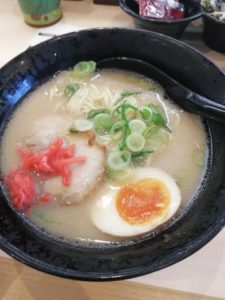
Finding sushi is quite easy when you live in Japan. Every market and convenience store sells sushi you can buy, but the kind of sushi might depend on the prefecture and season. The most common types are maguro or tuna, and salmon. These two fish you will see all year round being sold in the markets.
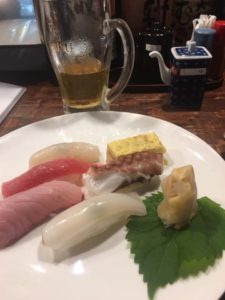
Now if you go to a restaurant or izakaya, you will have more choices of sushi types. You can choose from tuna, salmon, mackerel, octopus, squid, egg, shrimp, and etc. Again, it will depend on the time of year and area. The picture here is a plate of sushi I ate on my second night of living in Japan. I was living in Yamaguchi where fugu or blowfish is very famous. I have even gone fishing and caught blowfish myself.
Fugu was on of my bucket list items and I was so happy I was able to complete it. And to describe the taste, fugu is a chewy fish with very little actual taste. So, be sure to pair it with different sauces and wasabi when eating.
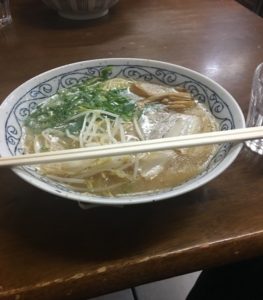 Ramen is similar to sushi in that you can find it everywhere. Now, if you have not visited Japan yet, I will warn you not to be alarmed by the “slurp” culture here.
Ramen is similar to sushi in that you can find it everywhere. Now, if you have not visited Japan yet, I will warn you not to be alarmed by the “slurp” culture here.
When eating any type of noodles, it is normal and seen as a good thing when you slurp up your noodles. In fact it is essential since ramen is served hot; otherwise it can take you a while to eat. So, don’t hold back while eating a delicious bowl of ramen. For me, the best parts are the meat and the soup broth.
So, if you are thinking about living and working in Japan, I say go for it. It will be a big journey whether you stay here for one year or several years. But one thing is certain I feel: you will enjoy the food here. And even more than that, you’ll enjoy the authentic experience of trying it in Japan; that will always be one of the best parts about the food in Japan, in my humble opinion.
Photo Credits:
Top Photo: takedahrs on Pixabay
Additional photos were provided by Joshua Minor, used with permission.
All other content (text) created by the original author and © 2021 MUSUBI by Borderlink
Top Image: Irasutoya
Quick Tips are fast advice for busy people- the perfect thing to read on that morning commute!
When you first move to Japan, you don’t always end up in the location you want right away. While you may settle in and come to enjoy your new home, there’s always going to be that “what if I lived in…” question in your mind. Eventually, you may decide to just pick up and move to a different city, prefecture, island or what have you. While you can do this and it is quite normal for foreigners to move in Japan, you may not realize how many steps are involved to ensure that the transition is a smooth one.
But fear not! We’re here to provide you with a few of the basic things you need to be aware of if you plan on moving within Japan in the near future!
“Foreigner-friendly” apartments
As a foreigner, (especially one who might not speak Japanese fluently) finding an apartment can be difficult. Some places won’t rent out to foreigners because either they can’t speak enough English or they don’t want to take the risk of having a foreigner just walk out mid-contract without paying the rent.
Fortunately, there are a number of foreigner-friendly options, be they large real estate companies like Leopalace or smaller, individually-managed apartment complexes. The best way to start looking for places to live is through websites such as gaijinpot.com, eheya.com, and realestate.co.jp. If you are coming to Japan to teach English, most companies will help you with finding an apartment or they will provide you with one. In some cases, they may be able to help with your search, especially if you are moving to another area for work.
The Cost
You should be aware of the costs of moving. Here are some things to know upfront:
• The costs of getting rid of unwanted items. Yes, you have to pay for some large items if you don’t plan on taking them with you. Thankfully, smaller items that are still in good, working condition can be sold off at second-hand shops like Hard Off or any place with a buy-back (買取)service. You may need to make several trips, and don’t expect to get more than a fraction of what you paid, but this is an effective way to offload items that you don’t need anymore or can’t transport that aren’t worth just throwing away.
• The initial costs can be high. You should prepare a couple months’ worth of rent, as well as a thing called key money, (reikin 礼金, a one-time gift to the landlord similar to a security deposit, although it’s non-refundable) cleaning fees, and lock fees. Not every apartment requires these, but it’s best to be prepared. One advantage of living in an apartment run by a large company like Leopalace is they will waive some of the fees if you move to another apartment run by them, even mid-contract.
• Moving companies can be expensive depending on how far you are moving and how much stuff you have to move. If you have a Japanese license or an international driver’s license you could rent your own truck but, again this could get expensive as well. For this, we would suggest having between ¥50,000 and ¥100,000. If you do decide to go with a moving company, be sure to have them come and give you a free estimate. And, if your Japanese is good enough or you have a friend with you, see what kind of discounts they are willing to give you so you use their services rather than a competitors’!
In Conclusion
While the cost of moving can become quite expensive in Japan, as people who have all moved at least once if not more, moving isn’t all that difficult when you are organized and have people willing to help you out. Lastly, please be aware that this article is just covering the actual move. There are other things you’ll have to do with moving, such as changing your address and managing utilities. Stay tuned for our guide to those in the future!
Looking to relocate in Japan, teach English and seeking a company able to assist you? Borderlink is looking for you! For more information, read all about the job of an ALT!
Photo Credits:
Top Image: Irasutoya
All other content (text) created by the original author and © 2021 MUSUBI by Borderlink
Top photo: Zygel Doll Jamelano, used with permission
“It is probably one of the most underrated places you can visit in Tokyo and you wouldn’t know what you are missing until you get there.”
When we think about Japan, some of the most common things that enter our minds includes the technology, their world-famous green tea, their unique fashion sense, and their animation or anime. Some of the latter tend to stick out more than others — take Studio Ghibli for example. Now, imagine entering a village made up of accessory shops, restaurants and cat cafes heavily inspired by the charming setting of Ghibli movies — it sure will make you feel warm fuzzies even in winter time.
In the Tokyo’s Kichijoji is just such a place — the Petit Mura Complex. You will immediately notice it because of the number of people taking photos of the exteriors of the buildings and the crowds that sometimes build around it. Its exterior is made up of stained-glass windows, flowers and vines hugging the walls; its color has a unique tinge of grey that makes you feel like you just entered a picture book.
The complex itself is composed of four different areas inside. The first and perhaps most popular one is Temari no Oshiro which is the sister shop of Temari no Ouchi cat cafe. It boasts of 21 resident cats both young and old — and perhaps best of all is unlike other cat cafes where you need to pay per half hour, this place has no time limits.
You can order drinks and food while playing with their cats. The resident cats are quite friendly and motivate, and the food ‘s pretty good as well. The whole area is quite spacious inside and has three floors altogether which the guests and cats can roam freely — some cats even follow you around like this Norwegian Forest Cat named Lily who followed us everywhere we went.
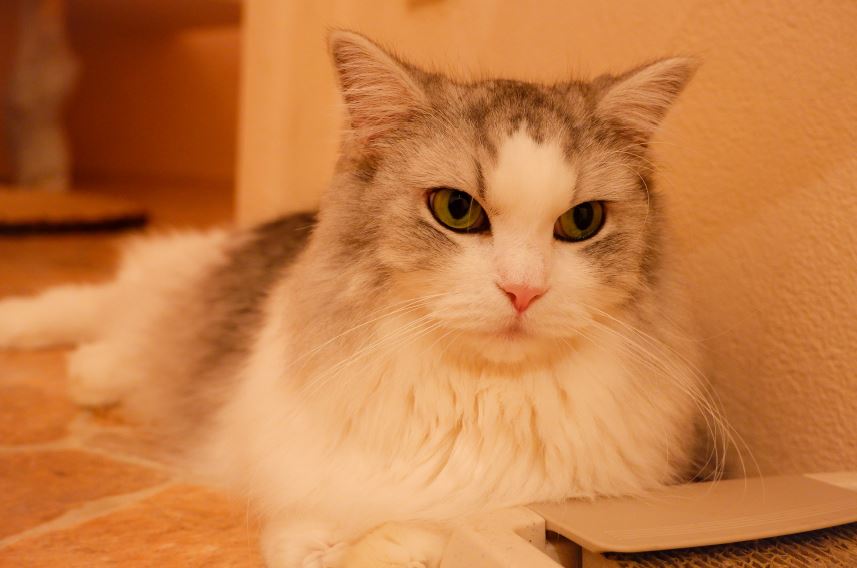
They have some rules which guests are expected to follow such as no hugging or carrying of the cats, use disinfectants before entering the cat cafe, and no use of flash photography. A visit on the weekdays will set you back about 1,200 yen plus tax. On weekends they usually charge around 1,600 yen and any day after 7 in the evening it’s 700 yen plus tax.
The second area within the village is called “Toko Toko Circus” which is an accessory and daily necessities store. Upon entering you’ll find yourself lost inside a forest of cat items — which aptly reflects the concept of the place. The place is supposed to represent the thoughts of “Milk the Minchkin” who lived in a mystical forest and made it her life’s dream to create a cat shop that would one day be famous all over the world.
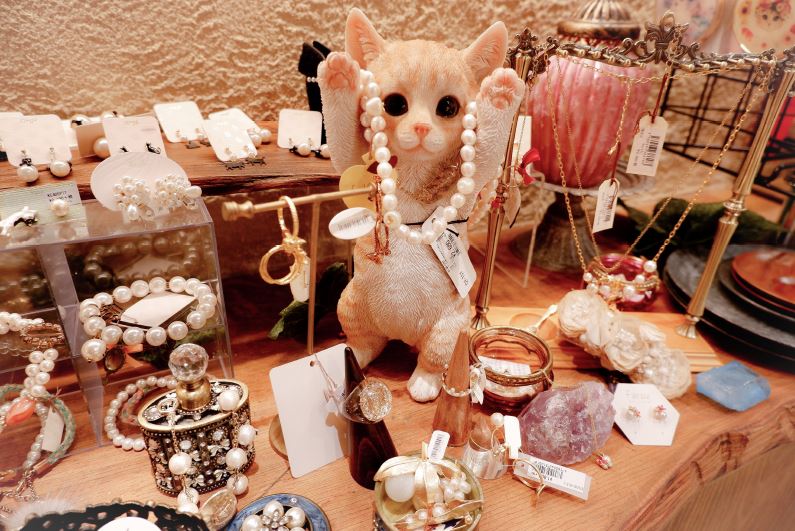
They’ve got every possible item you can think of: stationeries, kitchen items, stamps, bags, accessories, umbrellas – the list goes on.
The third and perhaps the most misunderstood part of this cat-village is their restaurant named “The Tea House Happa”. Just looking at the exteriors, you find yourself a little intimidated because it is absolutely breathtaking, which may lead most to have the wrong assumption — this place must be quite expensive. Thankfully, we tried dining there and realized that we paid about the same amount we’d usually spend when eating in chain restaurants like Saizeriya.
The interiors of the restaurant looks like the combination of autumn and dusk if it were a place. It makes you feel relaxed and at home — especially the aroma of the different teas brewing around you. We tried their rose tea which came in a beautiful glass pot. We dined on salmon bruschetta with an exquisite flavor made up of garlic, olives, shallots and oregano.
We also had their basil chicken sandwich and finished off with their fruit tart gelato. The restaurant if made up of two floors and the seating areas feature traditional Japanese and Italian designs. After eating, you may also go around and take a lot of photos. You can get more information about their menu from their website in here: https://teahouse-happa.com/
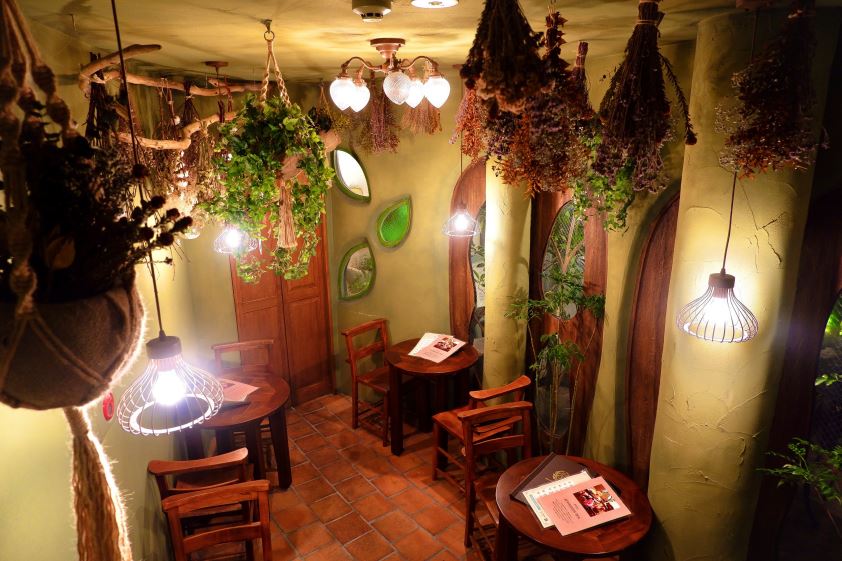
All in all, it was a great experience and worth visiting this place, whether you’re a cat lover or not. It is also located just a few minutes walk from Inokashira Park and all around the area are other quaint and unique shops you can visit. I’ve been there a few times after visiting the park and if you’re lucky, there may even be an art gallery present. I even bought my “Good job” stamp from there and my students absolutely adore it.
Will it make your bucket list?
Photo Credits:
All photos for this article were provided by Zygel Doll Jamelano, used with permission
All other content (text) created by the original author and © 2021 MUSUBI by Borderlink
